 What a Christmas present. Through Chris Vaughn and Wayne
Thomas, I was lucky enough to get included in a trip to visit the Natural
History Museum in London; but not only that, we were being allowed in the area
in the depths of the building not open to the public, being given a tour by
Oliver Crimmen (pictured with Wayne and myself), one of the world’s experts on fish experts.
What a Christmas present. Through Chris Vaughn and Wayne
Thomas, I was lucky enough to get included in a trip to visit the Natural
History Museum in London; but not only that, we were being allowed in the area
in the depths of the building not open to the public, being given a tour by
Oliver Crimmen (pictured with Wayne and myself), one of the world’s experts on fish experts.
I hadn’t appreciated that the majority of the world’s
vertebrae are fish with around 34,000 species know to date, greatly
exceeding mammals and birds and so five of the eight levels of storage at the museum are fish
species, totalling 5.5km of shelving, hugely impressive.
The museum stated in the 18th century when a vast
donation of items were made, many dating back to the 16th century,
or possibly even the 15th as the dates of items preserved were not
recorded back then. As we toured the facility, we could see the specimens were stored in three basic ways:-
As a skeleton. Here the specimen is put in with carpet
beetles, bred specifically for the job, which strip the flesh off leaving just a clean, but joined
skeleton. This method has major benefits over skeletons
found such as dinosaurs where the bones are dispersed, here they remain in
place as in the living animal. The
photograph shows the skeleton of a puffer fish being held by Oliver Crimmen
himself.
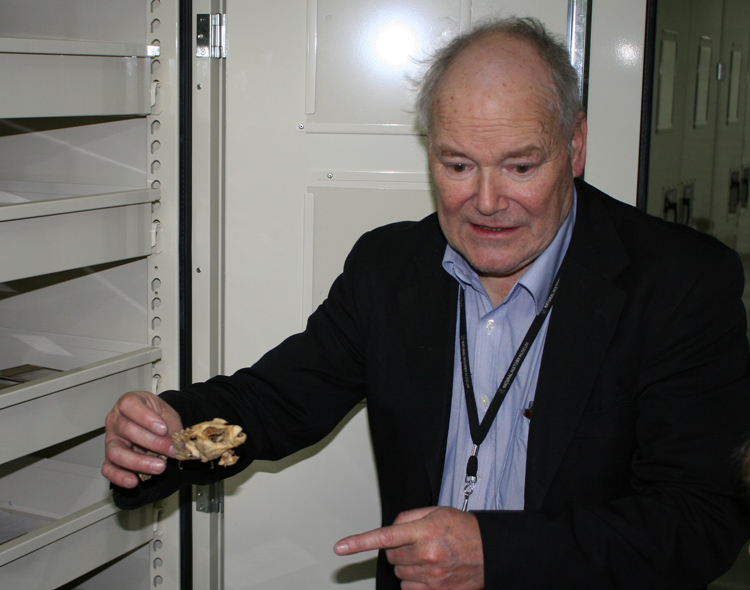
2)
The second way is storage as a skin (as the carp photographed) where most of the
bones are removed prior to drying. This has the advantage that the overall appearance of the
specimen is more complete giving a better visual appearance, and this is also
great for taking DNA samples.
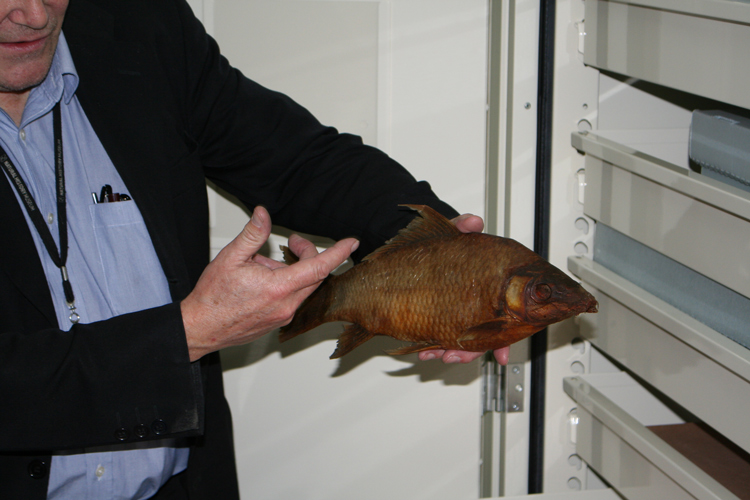
3)
The third way is storing the complete specimen in
alcohol. Currently formaldehyde is used which prevents decomposition but does
virtually eliminate the possibility of DNA testing (although progress in this
area is being made).
As the Museum has some of the oldest and most complete
specimens, many are designated the reference specimen for the species and by doing this, all
newer specimens can be compared to see if changes are happening in their
evolution. We were shown a massive sunfish (pictured) which was brought to the UK by Ramsey in 1838 (and named after him) who from the antipodes. Interestingly sunfish lay more eggs
than any other fish and one can spawn up to 300,000,000 eggs.
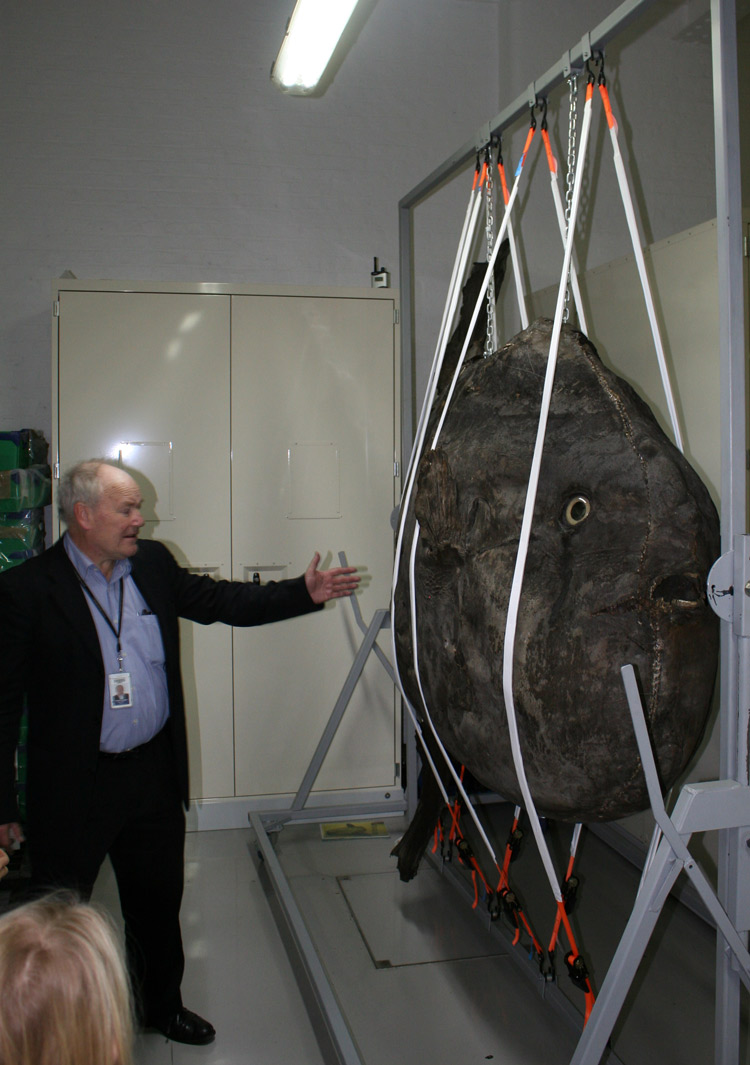
Evolution was a significant area of conversation and Oliver said on of the best examples in the wild is that of cichlids in Lake Victoria which over the last 750,000 years have
evolved into many differing species, each having a different niche in the cycle of life
there.
We were then shown how vast specimens such as a blue whale
have their bones scanned three dimensionally for future research. The one currently being prepared had approximately 155 seperate bones, with the skull having to be subcontracted due to the sheer size. This is significant for the NHM as the
diplodocus (skeleton replica) at the entrance of the museum is disappearing at
Christmas 2016 and is being replaced by the blue whale skeleton which we saw being scanned.
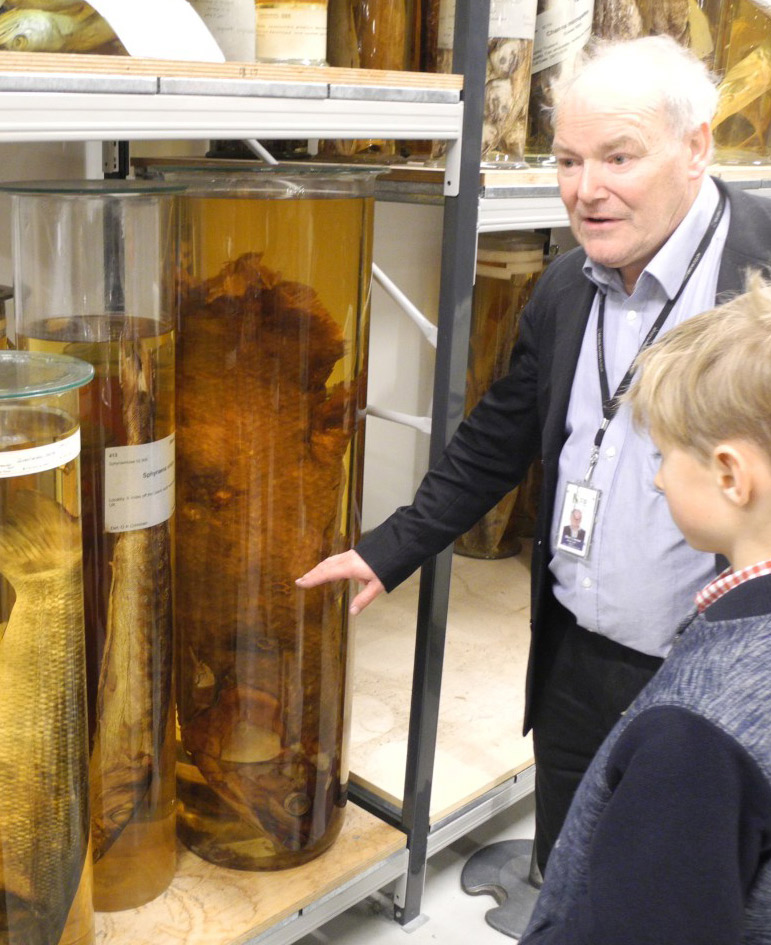
We ended the tour in the area where larger specimens are
stored and I achieved an ambition by seeing a coelacanth stored there, then a
large tank was opened an in it was a arapaima (which we were told have a primitive lung and
actually drown if kept permanently submerged), a yellowfin tuna from the west
coast of Wales, the head from a very big beluga sturgeon, a manta ray caught near
the Isle of Wight, an electric ray etc.,
all fascinating to see in the flesh. They are currently waiting for the
arrival of a carcass of a blue marlin washed up on the welsh coast.
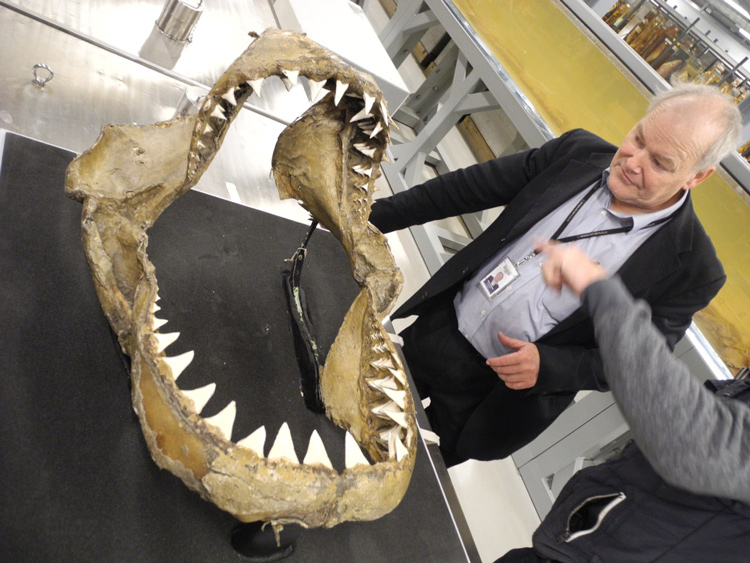 We were then educated about Sharks and their teeth looking at various specimens. Mako’s
have pointed teeth for holding fish, whereas the great white has triangular
teeth with serrated edges for biting and slicing seals, and as the photographs show, not only do they have the teeth set for biting in the gum, but replacement teeth ready to move into place as these fall out. As sharks don't have bone structures have a skeleton made from cartilidge, the tissue around the teeth allows a succession to be grown and rotate into place. Tiger shark’s teeth have a combination of both styles
and are the only fish that can chew through the shell of a turtle.
We were then educated about Sharks and their teeth looking at various specimens. Mako’s
have pointed teeth for holding fish, whereas the great white has triangular
teeth with serrated edges for biting and slicing seals, and as the photographs show, not only do they have the teeth set for biting in the gum, but replacement teeth ready to move into place as these fall out. As sharks don't have bone structures have a skeleton made from cartilidge, the tissue around the teeth allows a succession to be grown and rotate into place. Tiger shark’s teeth have a combination of both styles
and are the only fish that can chew through the shell of a turtle.
One other thing that I did learn was that the skin
of the shark family such a dogfish is abrasive, and this roughness is actually a covering
of very fine teeth. That is why it feels
smooth one way and rough enough to scrape away skin in the other. This has evolved as a means to allow them to
swim using much less energy than a smooth skin.
(Speedo tried to copy this for olympic swimming shorts but it has been
banned by the IOC)
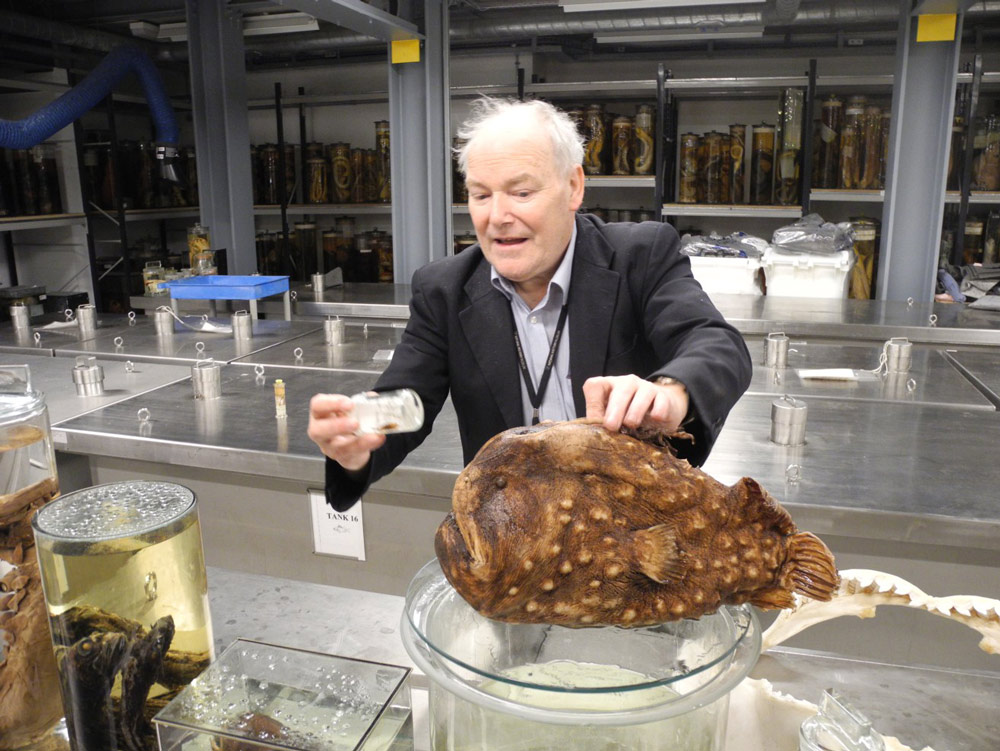
We also saw fish from the deep such as an angler fish with a
light to attract it prey where the male is the size of a broad bean and is
permanently attached to the female and when joined, he relies on her for all
his nourishment. You can see both in the picture with the male in the jar.
We had a lengthy discussion about the exotics appearing
around the coasts of the UK
in recent years and asked if that could be attributed to global warning. There
was a distinct reticence to confirm this as several other factors come into
play. Firstly, people are more aware of
what is not the norm and with the internet, it is possible to bring these to
the attention of the experts. Technology for the capture of such species has
also improved. Wayne highlighted trigger fish
appearing off the North Devon coast for a few
years and disappearing again. It was felt that these isolated incidents may
have happened for thousands of years due to warm periods, currents, movement of
food etc.; it is only when fish stay for longer, and breed so there becomes an
indigenous population that you can judge change to have happened, and then it
may be for a variety of factors, not just warming seas. (That is best indulged by the press)
 The final wonder was seeing a glass cabinet containing many of Darwin's exhibits from his trip on the Beagle, still with their handwritten notation, real history at your fingertips
The final wonder was seeing a glass cabinet containing many of Darwin's exhibits from his trip on the Beagle, still with their handwritten notation, real history at your fingertips
I don’t think this account does justice to the pleasure and education of the day as we saw
a stream of delights, asking many questions which were immediately answered. It
was truly fascinating and I could have spent several days just looking around
as there was so much to see, a day I will not forget.
A final thanks to Wayne Thomas for granting permission to use five of his photographs in this diary piece.